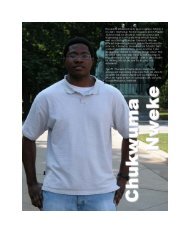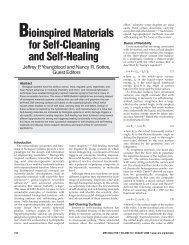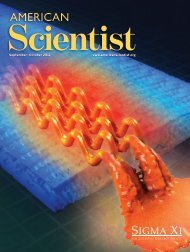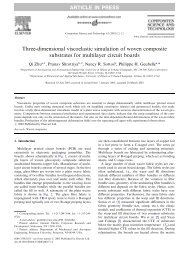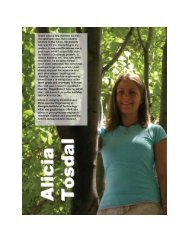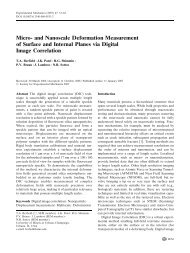Self-healing of a high temperature cured epoxy using poly ...
Self-healing of a high temperature cured epoxy using poly ...
Self-healing of a high temperature cured epoxy using poly ...
You also want an ePaper? Increase the reach of your titles
YUMPU automatically turns print PDFs into web optimized ePapers that Google loves.
Polymer 51 (2010) 4063e4068<br />
Contents lists available at ScienceDirect<br />
Polymer<br />
journal homepage: www.elsevier.com/locate/<strong>poly</strong>mer<br />
<strong>Self</strong>-<strong>healing</strong> <strong>of</strong> a <strong>high</strong> <strong>temperature</strong> <strong>cured</strong> <strong>epoxy</strong> <strong>using</strong> <strong>poly</strong>(dimethylsiloxane)<br />
chemistry<br />
C.L. Mangun a, *, A.C. Mader b , N.R. Sottos c,d , S.R. White d,e<br />
a CU Aerospace, 2100 S. Oak St., Suite 206, Champaign, IL 61820, USA<br />
b Hochschule Bremen, Neustadtswall 30, Bremen, D-28199, Germany<br />
c Dept. <strong>of</strong> Materials Science and Engineering, UIUC, 1304 W. Green St., Urbana, IL 61801, USA<br />
d Beckman Institute, UIUC, 405 N. Mathews Av., Urbana, IL 61801, USA<br />
e Dept. <strong>of</strong> Aerospace Engineering, UIUC, 104 S. Wright St., Urbana, IL 61801, USA<br />
article<br />
info<br />
abstract<br />
Article history:<br />
Received 5 April 2010<br />
Received in revised form<br />
25 June 2010<br />
Accepted 29 June 2010<br />
Available online 7 July 2010<br />
Keywords:<br />
Autonomic materials<br />
<strong>Self</strong>-<strong>healing</strong><br />
Microcapsules<br />
A <strong>high</strong> <strong>temperature</strong> <strong>cured</strong> self-<strong>healing</strong> <strong>epoxy</strong> is demonstrated by incorporating microcapsules <strong>of</strong> <strong>poly</strong><br />
(dimethylsiloxane) (PDMS) resin and separate microcapsules containing an organotin catalyst. Healing is<br />
triggered by crack propagation through the embedded microcapsules in the <strong>epoxy</strong> matrix, which releases<br />
the <strong>healing</strong> agents into the crack plane initiating crosslinking reactions. A series <strong>of</strong> tapered doublecantilever<br />
beam (TDCB) fracture tests were conducted to measure virgin and healed fracture toughness.<br />
Healing efficiencies, based on fracture toughness recovery, ranged from 11 to 51% depending on the<br />
molecular weight <strong>of</strong> PDMS resin, quantity <strong>of</strong> <strong>healing</strong> agent delivered, and use <strong>of</strong> adhesion promoters.<br />
Ó 2010 Elsevier Ltd. All rights reserved.<br />
1. Introduction<br />
Advanced fiber reinforced <strong>poly</strong>meric composites are widely used<br />
in many military and commercial applications as they provide a <strong>high</strong><br />
strength-to-weight ratio and are durable in harsh environments.<br />
However, <strong>poly</strong>mers are ultimately susceptible to failure by multiple<br />
mechanisms such as thermal/mechanical fatigue, microcracking,<br />
and debonding. <strong>Self</strong>-<strong>healing</strong> <strong>poly</strong>mers have potential to alleviate<br />
many <strong>of</strong> the damage mechanisms prevalent in structural composites<br />
thus greatly extending the operational lifetime and reliability <strong>of</strong><br />
these materials. Achieving successful self-<strong>healing</strong> in structural<br />
composites require chemistries that are robust, cost-effective,<br />
environmentally stable, and provide <strong>high</strong> <strong>healing</strong> efficiencies. The<br />
first successful <strong>healing</strong> system was achieved by White et al. via<br />
a metathesis reaction <strong>of</strong> encapsulated endo-dicyclopentadiene<br />
(DCPD) monomer and first generation Grubbs’ catalyst [1]. Although<br />
this system meets many <strong>of</strong> the characteristics desired for self-<strong>healing</strong>,<br />
stability <strong>of</strong> the catalyst phase limits the processing <strong>temperature</strong><br />
to a maximum <strong>of</strong> ca. 40 C unless special environmental control is<br />
maintained. For <strong>high</strong> performance structural composites, processing<br />
requirements dictate that a self-<strong>healing</strong> system must survive<br />
elevated <strong>temperature</strong> (100e200 C) for several hours.<br />
* Corresponding author. Tel.: þ1 217 333 8279; fax: þ1 217 333 4726.<br />
E-mail address: cmangun@cuaerospace.com (C.L. Mangun).<br />
PDMS <strong>healing</strong> chemistries have been used previously for room<br />
<strong>temperature</strong> <strong>cured</strong> <strong>poly</strong>mers such as vinyl ester, <strong>epoxy</strong>, and PDMS<br />
elastomer [2e5]. The PDMS system has several advantages as an<br />
alternative <strong>healing</strong> chemistry including stability at elevated<br />
<strong>temperature</strong>s, the components are widely available and comparatively<br />
low in cost, and encapsulation is relatively straightforward.<br />
Cho et al. [3] utilized a two-component system with silanolterminated<br />
<strong>poly</strong>dimethylsiloxane (PDMS) and the crosslinker <strong>poly</strong>diethoxysiloxane<br />
(PDES) phase separated in a vinyl ester matrix<br />
together with a microencapsulated organotin catalyst. Healing<br />
efficiency ca. 24%, based on fracture toughness recovery, was achieved<br />
after 24 h at 50 C. Cho et al. [4] extended this research by<br />
microencapsulating both component phases (resin & catalyst) and<br />
incorporating them into either vinyl ester or <strong>epoxy</strong> coatings on<br />
steel substrates for corrosion protection.<br />
Although the PDMS system is not capable <strong>of</strong> recovering the full<br />
fracture toughness <strong>of</strong> an <strong>epoxy</strong>, it shows surprisingly good adhesion<br />
strength that suggests that it could function well for self-sealing<br />
applications. For example, Beiermann et al. [5] demonstrated the<br />
ability to heal puncture damage <strong>using</strong> PDMS microcapsules in<br />
<strong>poly</strong>meric membranes <strong>of</strong> a <strong>poly</strong>urethane/nylon/PDMS laminate.<br />
One potential application for self-<strong>healing</strong> <strong>epoxy</strong> composites is<br />
cryogenic storage tanks, which are used as lightweight storage<br />
containers for liquid oxygen and hydrogen propellants for aerospace<br />
applications where microcracks are induced by thermal<br />
0032-3861/$ e see front matter Ó 2010 Elsevier Ltd. All rights reserved.<br />
doi:10.1016/j.<strong>poly</strong>mer.2010.06.050
4064<br />
C.L. Mangun et al. / Polymer 51 (2010) 4063e4068<br />
cycling [6]. Moll et al. have investigated this application <strong>using</strong> glass<br />
fiber reinforced <strong>epoxy</strong> composites with the DCPD and Grubbs<br />
catalyst self-<strong>healing</strong> system and the results show the potential for<br />
a fully autonomic self-sealing material [7].<br />
In this study, we incorporate the dual capsule PDMS <strong>healing</strong><br />
system in a <strong>high</strong> <strong>temperature</strong> <strong>cured</strong> <strong>epoxy</strong> matrix and assess<br />
<strong>healing</strong> performance through fracture testing. Crack propagation<br />
through the <strong>epoxy</strong> ruptures the microcapsules releasing the <strong>healing</strong><br />
agent and catalyst into the crack plane where they react and<br />
repair the damage automatically. Fig. 1 shows the room <strong>temperature</strong><br />
condensation reaction <strong>of</strong> PDMS.<br />
2. Methods and materials<br />
Three different molecular weights <strong>of</strong> silanol-terminated PDMS<br />
(S21, 4200 g/mol, 90e120 cSt; S31, 26,000 g/mol, 1000 cSt; S35,<br />
49,000 g/mol, 5000 cSt), PDES and dibutyltin dilaurate (DBTL) as<br />
the catalyst were obtained from Gelest. EPON 828 was purchased<br />
from Miller-Stephenson and diethylenetriamine (Ancamine DETA)<br />
was received from Air Products. The urethane pre<strong>poly</strong>mer, Desmodur<br />
L75, was obtained from Bayer MaterialsScience. Solvents<br />
such as xylenes (a mixture <strong>of</strong> all three isomers) and hexyl acetate<br />
were purchased from SigmaeAldrich and used as received.<br />
2.1. Microencapsulation<br />
Fig. 2. Geometry <strong>of</strong> a short groove TDCB specimen (all dimensions in mm).<br />
PDMS microcapsules with urea-formaldehyde shells were<br />
prepared by in situ <strong>poly</strong>merization in an oil-in-water emulsion<br />
following a similar procedure as used by Brown et al. [8]. Stoichiometric<br />
amounts <strong>of</strong> PDMS and PDES were mixed beforehand<br />
and utilized as the core material. A full batch recipe was used with<br />
32.0 g <strong>of</strong> S21 and 28.6 g <strong>of</strong> PDES and a mixing speed <strong>of</strong> 2000 rpm.<br />
Due to the <strong>high</strong>er molecular weight and therefore <strong>high</strong>er viscosity<br />
<strong>of</strong> the S31 and S35, the solvent xylenes was added to the core<br />
material prior to encapsulation. The minimum concentration <strong>of</strong><br />
xylenes to produce acceptable microcapsules was used in order to<br />
maximize the quantity <strong>of</strong> <strong>healing</strong> agent delivered. All reactant<br />
quantities were decreased by 50% and an agitation speed <strong>of</strong><br />
1800 rpm was used. The core material <strong>of</strong> the S31 capsules consists<br />
<strong>of</strong> a mixture <strong>of</strong> 16.5 g S31, 2.5 g PDES and 9.4 g xylenes (30% by<br />
weight). For the S35 capsules, the core consisted <strong>of</strong> 11.0 g S35, 1.1 g<br />
PDES and 15.2 g xylenes (53% by weight). Finally, in an attempt to<br />
achieve good strength <strong>using</strong> a <strong>high</strong>er molecular weight PDMS but<br />
avoiding solvent, one set <strong>of</strong> capsules was produced <strong>using</strong> a blend <strong>of</strong><br />
S31 and S21 with a core <strong>of</strong> 16.5 g S31, 5.7 g S21, and 7.6 g <strong>of</strong> PDES (no<br />
solvent). After reaction, the suspension <strong>of</strong> microcapsules was<br />
separated under vacuum with a coarse-fritted filter. The microcapsules<br />
were rinsed with deionized water at least three times,<br />
followed by a final rinse with heptane. After drying in air for<br />
24e48 h the microcapsules were sieved and the diameters between<br />
38 and 125 mm were kept for testing.<br />
Since DBTL catalyst was too viscous to encapsulate directly,<br />
a 50:50 mixture <strong>of</strong> DBTL and hexyl acetate was utilized with<br />
a <strong>poly</strong>urethane shell. A 400 mL beaker was placed in a <strong>temperature</strong>controlled<br />
water bath and agitated by a digital mixer with a speed <strong>of</strong><br />
1600 rpm 4.5 g Gum arabic was slowly dissolved in 40 mL deionized<br />
water. 10 g Hexyl acetate, 10 g DBTL and 2.5 g urethane pre<strong>poly</strong>mer<br />
were mixed in a separate beaker and then poured into the agitated<br />
solution. The beaker was covered with aluminum foil and heated to<br />
60 C. Agitation and <strong>temperature</strong> were maintained for 1e2 h.<br />
Afterwards, the capsules were kept in a warm water bath for at least<br />
24 h to separate as much gum arabic out <strong>of</strong> the suspension as<br />
possible. Then the capsules were filtered and air-dried for 24e48 h<br />
(no sieving was necessary).<br />
2.2. Microcapsule characterization<br />
Mean diameter and standard deviation were determined from<br />
multiple images taken with a Leica optical microscope interfaced<br />
with ImageJ s<strong>of</strong>tware. A minimum <strong>of</strong> 120 measurements was made<br />
for each analysis. Images <strong>of</strong> the fracture surface were taken <strong>using</strong><br />
a SEM (FEI/Philips XL30 ESEM FEG). Thermogravimetric analysis<br />
(TGA) was performed on a Mettler-Toledo TGA851 <strong>using</strong> a nitrogen<br />
atmosphere and a heating rate <strong>of</strong> 10 C/min.<br />
2.3. Sample preparation<br />
Using the protocol established by Brown et al. [9], <strong>healing</strong> efficiency<br />
was measured by carefully controlled fracture experiments<br />
for both the virgin and healed specimens. These tests utilize<br />
a tapered double-cantilever beam (TDCB) geometry, which ensures<br />
controlled crack growth along the centerline <strong>of</strong> a brittle <strong>epoxy</strong><br />
specimen. However, the specimens used in this work differ from<br />
those described in Brown et al. [9] in that capsules are included<br />
only in the 7 64 mm center section near the centerline groove as<br />
introduced by Rule et al. [10]. The specimen geometry is shown in<br />
Fig. 2.<br />
Fig. 1. Condensation reaction <strong>of</strong> silanol-terminated PDMS and its crosslinker PDES. Organotin functions as the catalyst to initiate crosslinking.
C.L. Mangun et al. / Polymer 51 (2010) 4063e4068 4065<br />
Fig. 3. Optical microscope images <strong>of</strong> (a) S31 capsules and (b) organotin capsules.<br />
Samples for fracture testing were prepared by mixing EPON 828<br />
and 12 pph DETA curing agent and pouring into a closed silicone<br />
rubber mold. All TDCB samples were <strong>cured</strong> for 24 h at room<br />
<strong>temperature</strong>, followed by 24 h at 35 C and a final heat treatment at<br />
100 C for 1 h. Three different specimen types were investigated.<br />
The first type, designated as “reference” specimens, was conducted<br />
by manually injecting 5 mL <strong>of</strong> a pre-mixed solution, including both<br />
PDMS and catalyst in the proper ratio to mimic their respective<br />
capsules, into the crack plane. The second type, in situ or self<strong>healing</strong>,<br />
were prepared <strong>using</strong> TDCB specimens with capsules that<br />
were stirred into the EPON 828:DETA matrix at various loadings by<br />
weight (1e15 wt% <strong>of</strong> PDMS capsules with corresponding 0.1e1.5 wt<br />
% DBTL capsules) and poured only into the central region <strong>of</strong> the<br />
samples. Finally, several sets <strong>of</strong> TDCB “control” samples were<br />
fabricated with 5 wt% <strong>of</strong> each type <strong>of</strong> capsule (S21, S31, or S35) and<br />
0.5 wt% <strong>poly</strong>urethane capsules that contained only hexyl acetate<br />
(no catalyst).<br />
The influence <strong>of</strong> adhesion promoters was also investigated by<br />
direct addition <strong>of</strong> silane coupling agents to the <strong>epoxy</strong> matrix. Three<br />
different silanes were obtained from Gelest and two combinations<br />
were tested: SIB1834.1 with a molecular formula <strong>of</strong> C 14 H 36 N 2 O 6 Si 2<br />
used at 2 wt% and designated as “amino silane” while the second<br />
set was designated as “mixed silane” consisting <strong>of</strong> 1 wt% each <strong>of</strong><br />
SIA0611.0, C 6 H 17 NO 3 Si, and SIB1832.0, C 12 H 30 O 6 Si 2 .<br />
2.4. Fracture testing<br />
In this protocol, <strong>healing</strong> efficiency is defined as the ability to<br />
recover mode-I fracture toughness, K Ic . During the initial virgin<br />
loading cycle, the self-<strong>healing</strong> specimen is loaded until the crack<br />
propagates through the insert groove section <strong>of</strong> the sample where<br />
the microcapsules reside. Prior to testing, a pre-crack was initiated<br />
with a razor blade into the groove <strong>of</strong> the sample. TDCB specimens<br />
were pin-loaded and tested to failure <strong>using</strong> an Instron load frame<br />
under displacement control at a rate <strong>of</strong> 5 mm/s. The samples were<br />
unloaded, allowing the crack faces to come back into contact, and<br />
then allowed to heal for 24 h at room <strong>temperature</strong> (without any<br />
external intervention, e.g. no applied heat or pressure) before again<br />
being loaded to failure. Average <strong>healing</strong> efficiencies are reported<br />
Table 1<br />
Microcapsule average diameters with standard deviation.<br />
Capsule Type<br />
Diameter (mm)<br />
S21 37 13<br />
S31 72 35<br />
S35 66 29<br />
S21/S31 58 24<br />
Catalyst 33 7.1<br />
based on sets <strong>of</strong> 3e5 samples. The tapered geometry is designed so<br />
that the resulting fracture toughness measurement is independent<br />
<strong>of</strong> crack length, and <strong>healing</strong> efficiency (h s ) is expressed simply as<br />
a ratio <strong>of</strong> the peak loads (P c ) <strong>of</strong> the healed and virgin samples.<br />
h s ¼ K Ic healed<br />
K Ic virigin<br />
3. Results and discussion<br />
¼ P c healed<br />
P c virigin<br />
(1)<br />
3.1. Microcapsule characterization<br />
A representative image <strong>of</strong> the PDMS microcapsules is shown in<br />
Fig. 3a for the S31 system.<br />
In general, the S21 was the best capsules in terms <strong>of</strong> shape and<br />
free-flowing nature with little debris. Whereas the <strong>high</strong>er viscosity<br />
S31 or S35 resulted in microcapsules that were less uniform in<br />
shape with more debris and a tendency to cluster. Although the<br />
same range <strong>of</strong> capsules (38e125 mm) were sieved, the average<br />
diameter <strong>of</strong> each batch varied greatly and the standard deviation<br />
was quite large (Table 1).<br />
TGA experiments (Fig. 4a) showed that the thermal stability <strong>of</strong><br />
the S31 and S35 was greatly influenced by both the inclusion <strong>of</strong><br />
xylenes and to some extent, poorer capsule quality (note that the<br />
first drop in mass loss occurred for the S35 before the S31).<br />
However, both S21 and the S21/S31 capsules showed practically no<br />
mass loss until at least 200 C and an appreciable decline does not<br />
occur until 250 C when the PDES component is most likely boiling<br />
away. At <strong>high</strong>er <strong>temperature</strong>s, the remaining PDMS starts to char as<br />
the mass steadily decreases with <strong>temperature</strong>.<br />
The catalyst capsules were <strong>of</strong> uniform shape with no debris<br />
(Fig. 3b) and a fairly narrow size distribution with an average<br />
diameter <strong>of</strong> 33 mm (Table 1). Although they tended to agglomerate<br />
after drying (probably due to remnants <strong>of</strong> the gum arabic), they<br />
would readily break apart and disperse evenly when stirred into<br />
<strong>epoxy</strong>. TGA curves <strong>of</strong> the catalyst capsules along with the corresponding<br />
core materials <strong>of</strong> 50:50 DBTL and hexyl acetate are shown<br />
in Fig. 4b. The hexyl acetate in the solution evaporates rapidly at ca.<br />
120 C. When this core material was encapsulated, the thermal<br />
stability doubles to almost 250 C. After the capsule shells rupture,<br />
the core content is quickly liberated near 300 C.<br />
3.2. Control samples<br />
Multiple sets <strong>of</strong> TDCB samples were made as controls with 5 wt%<br />
<strong>of</strong> each type <strong>of</strong> capsule (S21, S31, or S35) and 0.5 wt% <strong>poly</strong>urethane<br />
capsules that contained only hexyl acetate (no catalyst).
4066<br />
C.L. Mangun et al. / Polymer 51 (2010) 4063e4068<br />
a<br />
100<br />
b<br />
100<br />
90<br />
80<br />
80<br />
Catalyst Solution<br />
Catalyst Capsules<br />
(%)<br />
Loss<br />
Mass<br />
70<br />
60<br />
50<br />
40<br />
30<br />
S21 Caps<br />
S31 Caps<br />
S35 Caps<br />
S21/S31 Caps<br />
Mass Loss (%)<br />
60<br />
40<br />
20<br />
20<br />
0 100 200 300 400 500 600<br />
Temperature (C)<br />
0<br />
0 100 200 300 400 500<br />
Temperature (C)<br />
Fig. 4. TGA plots <strong>of</strong> (a) the different PDMS capsules and (b) the catalyst solution (DBTL plus hexyl acetate) with corresponding capsules.<br />
These controls verified if the <strong>healing</strong> was due to the catalyzed<br />
reaction <strong>of</strong> the PDMS and not other factors (e.g. the inherent<br />
tackiness <strong>of</strong> PDMS). Fig. 5 shows representative load-displacement<br />
curves for the S35 control along with its corresponding in situ self<strong>healing</strong><br />
sample. Note the distinct difference in the two plots: the<br />
healed curve has the same stiffness <strong>of</strong> the virgin material until the<br />
PDMS starts to tear away from the crack plane, leading to<br />
a distinctive healed peak. After the healed material debonds, the<br />
curve loads up along the same line as the last segment <strong>of</strong> the virgin<br />
test. For the control sample in the second plot, the curve immediately<br />
lines up with the end <strong>of</strong> the virgin test thus indicating that no<br />
<strong>healing</strong> has taken place.<br />
3.3. Reference and in-situ samples<br />
A summary <strong>of</strong> the TDCB <strong>healing</strong> efficiencies for the PDMS<br />
capsules is shown in Fig. 6. In addition, several sets <strong>of</strong> reference<br />
samples were prepared <strong>of</strong> the matrix <strong>poly</strong>mer alone and healed<br />
manually by injecting a pre-mixed solution <strong>of</strong> the appropriate<br />
<strong>healing</strong> system as described in Methods section (data is represented<br />
as solid lines in Fig. 6).<br />
In order to give a more straightforward comparison <strong>of</strong> the in situ<br />
<strong>healing</strong> data versus each capsule type (since the capsule size and<br />
mass fraction <strong>of</strong> resin in the core varied), the results were plotted<br />
against the amount <strong>of</strong> PDMS delivered (mg/cm 2 ). The mass <strong>of</strong><br />
<strong>healing</strong> agent delivered to the crack plane was calculated with the<br />
equation developed by Rule et al. [10] as:<br />
M Resin ¼ r s 4D c x (2)<br />
where r s is the density <strong>of</strong> the matrix, 4 is the mass fraction <strong>of</strong><br />
microcapsules in the <strong>epoxy</strong> matrix and D c is the mean diameter <strong>of</strong><br />
the microcapsules. In this study, the quantity x represents the<br />
weight fraction <strong>of</strong> PDMS resin in the core (e.g. this value would 1 for<br />
S21, 0.7 for S31, etc.). In addition, several SEM images were taken <strong>of</strong><br />
the fracture surface that clearly indicate ruptured microcapsules<br />
where the PDMS resin has reacted with the catalyst to form an<br />
extensive healed film (Fig. 7).<br />
The reference <strong>healing</strong> efficiencies followed the expected trend,<br />
as the molecular weight increased, the strength <strong>of</strong> the <strong>poly</strong>merized<br />
PDMS resin increased. The blend <strong>of</strong> S21/S31 <strong>healing</strong> mixture fell<br />
between the results for S21 and S31 in almost exactly the calculated<br />
value based on the proportions <strong>of</strong> each component. The in situ<br />
<strong>healing</strong> efficiencies from Fig. 6 exhibit the same trend as observed<br />
for the reference samples. Although quite close for the S21 sample,<br />
the in situ values are <strong>high</strong>er for the <strong>high</strong>er viscosity PDMS samples<br />
when compared to the reference. Typically, TDCB reference tests<br />
are utilized as an indicator <strong>of</strong> the maximum h s that can be achieved<br />
for an encapsulated system. This decrease in <strong>healing</strong> efficiency is<br />
attributed to difficulty <strong>of</strong> injecting the viscous <strong>healing</strong> agents into<br />
the crack plane. <strong>Self</strong>-<strong>healing</strong> samples, however, have uniform<br />
a<br />
80<br />
70<br />
60<br />
Virgin Peak Load<br />
b<br />
120<br />
100<br />
N )<br />
50<br />
N )<br />
80<br />
o a d (<br />
40<br />
o a d (<br />
60<br />
L<br />
30<br />
20<br />
10<br />
Healed Peak Load<br />
Virgin<br />
Healed<br />
L<br />
40<br />
20<br />
Virgin<br />
Healed<br />
0<br />
0 200 400 600 800 1000<br />
0<br />
0 200 400 600 800 1000 1200<br />
Displacement ( µ m)<br />
Displacement ( µ m)<br />
Fig. 5. Representative load-displacement curves for TDCB fracture specimens <strong>of</strong> (a) in situ 5 wt% S35 capsules displaying ca. 33% <strong>healing</strong> efficiency and (b) an S35 control (no<br />
<strong>healing</strong>).
C.L. Mangun et al. / Polymer 51 (2010) 4063e4068 4067<br />
Healing Efficiency (%)<br />
40<br />
35<br />
30<br />
25<br />
20<br />
15<br />
10<br />
S21<br />
S31<br />
5<br />
S35<br />
S21/S31<br />
0<br />
0 0.1 0.2 0.3 0.4 0.5 0.6 0.7 0.8<br />
PDMS Delivered (mg/cm 2 )<br />
Fig. 6. Summary <strong>of</strong> in situ <strong>healing</strong> efficiencies for PDMS capsules. Error bars represent<br />
one standard deviation. Solid lines indicate the corresponding value for reference<br />
samples.<br />
delivery across the crack plane from fractured microcapsules. For<br />
the S21 specimens, h s is fairly constant over the entire range <strong>of</strong> mass<br />
delivered. The S21/S31 shows a modest increase in h s with a plateau<br />
reached around 0.3 mg/cm 2 (which corresponds to the volume <strong>of</strong><br />
<strong>healing</strong> agent needed to fill the crack in a short groove TDCB). For<br />
the two PDMS capsules containing solvent, S31 and S35, there is<br />
again a peak around 0.3 mg/cm 2 but h s tends to fall as the amount<br />
delivered increases. This decrease could be due to the much larger<br />
volume <strong>of</strong> xylenes released at <strong>high</strong>er capsule loadings that could<br />
interfere with PDMS condensation reaction and/or causes swelling<br />
<strong>of</strong> the reacted <strong>poly</strong>mer if it does not evaporate. However, the S35<br />
system yields the best h s value <strong>of</strong> ca. 35% although the standard<br />
deviations are the largest <strong>of</strong> all samples. Variability is likely due to<br />
the poorer capsule quality (i.e. lower thermal stability, non-spherical)<br />
and the presence <strong>of</strong> debris, either from reactants not incorporated<br />
into shell walls or broken microcapsules. Based on the<br />
reference values, one would expect the S35 to achieve an even<br />
<strong>high</strong>er h s than 35%. Hence, there is a trade-<strong>of</strong>f when <strong>using</strong> a <strong>high</strong>er<br />
molecular weight PDMS, which increases the viscosity <strong>of</strong> the core<br />
thus necessitating solvent and degrades capsule quality and<br />
thermal stability. Finally, it is interesting to note that the samples<br />
with ca. 0.05 mg/cm 2 <strong>of</strong> S31 (equivalent to only 0.9 wt% capsules)<br />
achieve a h s <strong>of</strong> 22%. Fewer capsules are therefore needed to render<br />
the matrix self-<strong>healing</strong>, facilitating integration into a composite<br />
matrix.<br />
Table 2<br />
Summary <strong>of</strong> adhesion promoter results <strong>using</strong> a constant 0.3 mg/cm 2 PDMS delivered<br />
in situ.<br />
Capsule Type Adhesion promoter Avg <strong>healing</strong> efficiency (%)<br />
S21/S31 e 25.1 1.1<br />
S21/S31 Amino silane 33.4 3.4<br />
S21/S31 Mixed silane 45.1 2.3<br />
S35 e 34.2 4.6<br />
S35 Amino silane 44.6 2.4<br />
S35 Mixed silane 51.7 3.5<br />
3.4. Effect <strong>of</strong> adhesion promoters<br />
From observation <strong>of</strong> the PDMS <strong>healing</strong> film on the TDCB<br />
samples, it was apparent that in all cases, the failure was mainly<br />
adhesive in nature (i.e. the <strong>poly</strong>merized PDMS would only be<br />
present on one side <strong>of</strong> the fracture surface in any given area).<br />
Therefore two sets <strong>of</strong> adhesion promoters, based upon silane<br />
coupling agents, were examined by directly mixing with <strong>epoxy</strong><br />
matrix. The first (designed as “amino silane”) contained two<br />
primary amine groups to bond with the <strong>epoxy</strong> matrix and three<br />
methoxy groups on each end to react with the silanol-terminated<br />
PDMS. The second was a mixture <strong>of</strong> two coupling agents (designated<br />
as “mixed silane”) and contained equal amounts <strong>of</strong> an<br />
amine/methoxy compound and one that had no amine functional<br />
groups but just the three methoxy groups on each end. The self<strong>healing</strong><br />
results from several in situ specimens are shown in Table 2<br />
(a constant value <strong>of</strong> 0.3 mg/cm 2 PDMS delivered was used for<br />
easier comparison). In all cases, the use <strong>of</strong> silane coupling agents<br />
had a positive effect on h s with the mixed silane yielding the best<br />
results. For example, the h s for S21/S31 sample increased from 25.1<br />
to 33.4% for the amino silane and up to 45.1% for the mixed silane,<br />
an almost 80% improvement. Similar results were obtained for the<br />
S35 capsules, which also generated the <strong>high</strong>est h s <strong>of</strong> 51.7% <strong>using</strong><br />
the mixed silane.<br />
3.5. High <strong>temperature</strong> treatment<br />
An additional set <strong>of</strong> in situ S21/S31 specimens with mixed silane<br />
coupling agents was prepared with a <strong>high</strong>er <strong>temperature</strong> posttreatment<br />
<strong>of</strong> 4 h at 177 C (i.e. typical final cure <strong>temperature</strong> for<br />
a commercial structural <strong>epoxy</strong> composite) to evaluate the thermal<br />
stability <strong>of</strong> the encapsulated <strong>healing</strong> agents. This system was<br />
chosen as it had the best stability according to TGA (i.e. no solvent)<br />
in combination with a <strong>high</strong> h s <strong>of</strong> 45.1 2.3 (Table 2). The fracture<br />
tests resulted in a h s <strong>of</strong> 28.0 3.3, which is over 60% retention <strong>of</strong><br />
self-<strong>healing</strong> efficiency when compared to the standard cure cycle<br />
for this resin system. Since the coupling agents should be stable in<br />
this <strong>temperature</strong> range, the loss <strong>of</strong> h s could be due to leakage <strong>of</strong> the<br />
microcapsules and/or degradation <strong>of</strong> the PDMS components. The<br />
TGA data indicates the capsules are stable at this <strong>temperature</strong> range<br />
thus it seems likely that some auto-<strong>poly</strong>merization has taken place.<br />
Regardless, this data is quite encouraging for future development <strong>of</strong><br />
<strong>high</strong> performance structural composites that require <strong>high</strong><br />
<strong>temperature</strong> fabrication techniques.<br />
4. Conclusions<br />
Fig. 7. Representative SEM image <strong>of</strong> a TDCB fracture surface, the specimen contains<br />
15 wt% S31 capsules and 1.5 wt% catalyst capsules.<br />
A self-<strong>healing</strong> system in a fully <strong>cured</strong> <strong>epoxy</strong> matrix was achieved<br />
by incorporating urea-formaldehyde encapsulated PDMS resin and<br />
urethane encapsulated organotin catalyst. The thermal stability <strong>of</strong><br />
these microcapsules was measured with TGA and found to be at<br />
least 100 C and up to 200 C when no solvent was used in the core.<br />
TDCB specimens were fabricated and tested to determine <strong>healing</strong>
4068<br />
C.L. Mangun et al. / Polymer 51 (2010) 4063e4068<br />
efficiency, based on fracture toughness recovery. The <strong>healing</strong> efficiencies<br />
ranged from 11 to 35% and increased as the molecular<br />
weight <strong>of</strong> the PDMS resin increased. Examination <strong>of</strong> the <strong>healing</strong><br />
film showed only adhesive failure, thus the use <strong>of</strong> silane coupling<br />
agents was explored. Use <strong>of</strong> these adhesion promoters resulted in at<br />
least 30% and up to 80% improvement in <strong>healing</strong> efficiency with the<br />
<strong>high</strong>est value <strong>of</strong> 51% obtained. In addition, this is the first demonstration<br />
<strong>of</strong> self-<strong>healing</strong>, based on encapsulated <strong>healing</strong> agents, for<br />
<strong>high</strong> <strong>temperature</strong> (177 C) cure conditions. This allows for the<br />
possibility <strong>of</strong> fabricating <strong>high</strong> performance composites that have<br />
viable self-<strong>healing</strong> components even after <strong>high</strong> <strong>temperature</strong> posttreatments.<br />
This <strong>healing</strong> system could be quite practical for applications<br />
such as self-sealing (e.g. cryogenic storage tanks) and<br />
current research is examining this functionality <strong>using</strong> the optimal<br />
systems as determined by this TDCB study.<br />
Acknowledgements<br />
The authors would like to acknowledge funding provided by the<br />
Air Force Office <strong>of</strong> Scientific Research (Contract #FA9550-08-C-<br />
0037) and thank our Program Manager, Dr. Les Lee. In addition, the<br />
authors would like to thank members <strong>of</strong> the Autonomous Materials<br />
Systems group at the University <strong>of</strong> Illinois, Mary Caruso, Brett<br />
Beiermann, Jericho Moll, Benjamin Blaiszik, David McIlroy, Stuart<br />
Schelkopf and Gerald Wilson. Finally, thanks to Gelest for discussions<br />
on appropriate adhesion promoters, Todd Kamyszek at<br />
Wacker Chemical Corporation for his insights on the PDMS system,<br />
and Nigel Barksby and Paul H<strong>of</strong>fman at Bayer MaterialsScience for<br />
discussions on improved urethane pre<strong>poly</strong>mers and providing<br />
samples.<br />
References<br />
[1] White SR, Sottos NR, Geubelle PH, Moore JS, Kessler MR, Sriram SR, et al.<br />
Nature 2001;409:794e7.<br />
[2] Keller MK, White SR, Sottos NR. Advanced Functional Materials 2007;<br />
17:2399e404.<br />
[3] Cho SH, Andersson HM, White SR, Sottos NR, Braun PV. Advanced Materials<br />
2006;18:997e1000.<br />
[4] Cho SH, White SR, Braun PV. Advanced Materials 2009;21:645e9.<br />
[5] Beiermann B, Keller MW, Sottos NR. Smart Materials and Structures<br />
2009;18:085001.<br />
[6] Heydenreich R. Cryogenics 1998;38:125e30.<br />
[7] Moll JL, White SR, Sottos NR. Journal <strong>of</strong> Composite Materials; 2010.<br />
doi: 10.177/0021998306356605.<br />
[8] Brown EN, Kessler MR, Sottos NR, White SR. Journal <strong>of</strong> Microencapsulation<br />
2003;20(6):719e30.<br />
[9] Brown EN, Sottos NR, White SR. Experimental Mechanics 2002;42(4):372e9.<br />
[10] Rule JD, Sottos NR, White SR. Polymer 2007;48:3520e9.





